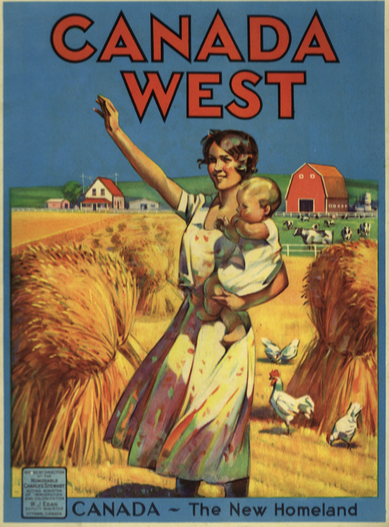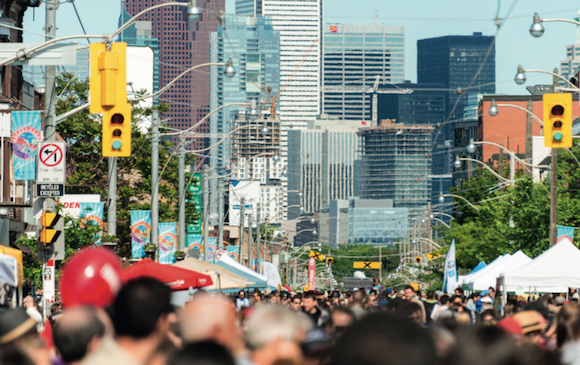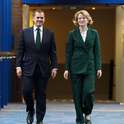In a packed House of Commons, the Conservative Party leader rose from the benches and spoke with passion about the plight of thousands of victims of Islamic State (IS) in Iraq. They needed the protection of the west and should be welcome in our country, she argued. MP after MP rose to echo the leader’s views. No-one claimed the nation’s well of hospitality would be exhausted; no-one suggested the children should be subject to dental checks to prove their age. A vote was called on whether to accept the refugees—more than 1,000 Yazidi women and girls. There were 313 votes in favour; not a single MP voted against. The national newspapers the next day were united in their approval; this was a moment of great pride for a nation that saw itself as tolerant and generous, with a sense of fair play. This was not some parallel universe, nor some distant time in history; this was Canada, last year.
Since the election of Liberal Prime Minister Justin Trudeau in 2015, Canada has been revelling in its position as a global liberal beacon. While many European nations have balked at the idea of accepting Syrian refugees fleeing terror, Trudeau announced that Canada would invite 25,000 Syrians immediately. He even turned up at the airport to greet them as “new Canadians” and personally handed out winter coats.
As last August’s Yazidi vote showed, such sympathy is bipartisan. “We’ve always had a very generous refugee programme in Canada,” Rona Ambrose, the then Conservative Party leader who led the charge in the Commons, told me. “I thought this was something I could make a difference on.” The idea that a centre-right party wouldn’t speak up on behalf of refugees strikes Ambrose as strange (she gasps when I mention the discussion in the UK about possible dental checks of child refugees). “There is a consensus on the importance of immigration and refugees for our country,” she says. “It’s not unusual that we [the Conservatives] would do something on human rights.”
Canada’s immigration policy isn’t just about compassion—there’s calculation too. While happily accepting more refugees per capita than most western nations, its openness extends to migrants as well. Each year the government sets a target for the number of immigrants it wants, based on what the economy needs. Provinces and cities compete to host them. The government even encourages people to apply. The country’s immigration minister visited China last August in order to persuade government officials to double, and eventually triple, the number of offices where Chinese could apply for Canadian visas.
Last year the government set a target of 300,000 immigrants. That figure was broken down into more than a dozen different categories, with each given its own target. For instance, in 2015, Canada sought to bring in up to 30,000 people to work in the care industry, some 51,000 skilled workers, and around 20,000 parents and grandparents of immigrants already in the country. Unlike the UK, Canada chooses not to include international students in its overall figures, as they are temporary residents.
The largely unplanned flow of newcomers into the UK is, demographically, remarkably similar to the immigration Canada pro-actively courts. Last year 588,000 people arrived here, just shy of 1 per cent of the overall population of 65m. Canada’s 300,000 target is, likewise, a little under 1 per cent of its population. However, while the release of UK immigration statistics each quarter is greeted with a bout of hand-wringing, renewed promises to reduce the figure and anti-immigrant coverage in newspapers, in Canada it’s a little different. When the target was hit last year politicians on all sides voiced their approval; the newspapers were supportive. This year, once again, the government wants another 300,000 immigrants to come to Canada.
Canada has achieved something no other western nation can claim—it has built a liberal immigration system that takes a humanitarian attitude towards asylum seekers, while also bringing in hundreds of thousands of economic migrants through a well-planned, orderly process that—crucially—has broad public support. “We have, by and large, a public consensus for immigration,” Senator Ratna Omidvar, an independent politician who has played a prominent role in the evolution of Canada’s immigration policy, told me. “It is impossible for any political party to be anti-immigrant. We argue about who should get in—should they have education, how many refugees—but we won’t argue about whether we should have immigrants.”
The British debate, meanwhile, has been reduced to a conversation about prevention—essentially, how can we stop so many people coming? Since the referendum, liberals have been trapped in a cul-de-sac, endlessly debating the rights and wrongs of freedom of movement, but seemingly unable to have a conversation about how to build a sensible system that fits the country’s needs. If Britain leaves the European Union as expected, we will—as the slogan on the bus proclaimed—“take back control.” But what then? Once the UK has full control of its own borders, what sort of immigration policy should it have?
The Brexiteers claim they have a ready-made model in Australia. Barely a day went by during the referendum campaign without the phrase “Australian-style points-based system” passing the lips of Nigel Farage or Boris Johnson. The appeal of Australia to those angry about immigration is clear: this is an old Commonwealth nation with historic ties to the UK and—something which shouldn’t be overlooked—a majority-white population. It has also built a reputation as a nation that goes to extraordinary lengths to prevent would-be refugees from reaching its shores. The topic has swung elections—Tony Abbott’s successful campaign in 2013 owed much to the three-word slogan, “Stop the Boats.” Perhaps it is this image of a nation that literally sends out gunboats to stop people arriving that appeals to Ukip and the Conservative right.
It may be because pro-immigration politicians in Britain have been stuck in a defensive crouch that it never occurred to them to find a model of their own. But should they try to do so, they could do a lot worse than look towards another giant land of the old Commonwealth. On paper, the Australian and Canadian systems have much in common—they both operate points-based systems. But the political (not to mention cultural) emphasis between the two nations could not be more different. Where Australia gives the impression it is closed, Canada presents itself as open; while many Australians still view their nation as monocultural, Canada is comfortably multicultural.
With freedom of movement very possibly coming to an end, there is surely an opportunity for those who believe that immigration—properly managed—can be a force for good. Liberal politicians have struggled to champion an alternative. Is it time for them to start endorsing the Canadian model?
One of Canada’s big advantages is that it has been thinking in a serious way about the subject for a lot longer than we have. The very first law Canada passed after it became a democracy in 1848 was on immigration; one of the first ministries created in 1867, when it became a self-governing colony, was a ministry of immigration and citizenship. “We’ve had 170 years to get a policy, a ministry and a bureaucracy to work properly,” says the Canadian philosopher and novelist John Ralston Saul. In fact, it goes further back—long before Canada gained independence. “When the 50,000 Loyalists fled from the United States (during the American Revolution) they were given loans and horses,” he says. “When the Sauls came in 1840s they were given 100 acres each, some horses, cows, seed for two years and some cash.”
Admittedly, it helped that they were white. Like its neighbour to the south, Canada was both a nation of immigrants and a racist society. Unlike the US, however, where African-Americans have been a demographic reality since the 17th century, in Canada migration and race were traditionally the same issue.
“Not so many decades ago, Canada had an appallingly racist immigration policy,” says Michael Trebilcock, a law professor at the University of Toronto and the co-author of The Making of the Mosaic: A History of Canadian Immigration Policy. “We essentially only let in white folk from Europe. We refused to take any Jewish refugees during the Second World War and we interned most of our Japanese citizens.”
The progressive turn of Canada’s immigration policy came later, starting in the 1960s. A Conservative government, led by the lawyer and human rights activist John Diefenbaker, introduced a raft of legislation that made Canada a more liberal nation. Universal adult suffrage was finally introduced, as indigenous people were granted the vote, and the first ethnic minority politicians appointed to the cabinet. Diefenbaker also introduced the 1961 Immigration Act, which removed the explicit racial discrimination criteria that had previously existed in the official admissions process. Later in the decade, the Liberal government introduced the first points system, which embedded a clear set of rules governing immigration. As a result, Canada’s ethnic make-up began to change. Steadily, it began to embrace the idea of multiculturalism.
The same idea had some traction in British government in the 1960s, with home secretary Roy Jenkins being a keen advocate. But the multicultural argument proved easier to sustain in the Canadian context, where it helped not only adjust to new demographic realities, but also to distinguish a young country from its colonial past. Prior to the 1960s, the dominant story was of the British and the French making a pact to build a nation. By adopting multiculturalism, Canada “built a narrative in which immigrants can be incorporated,” says Irene Bloemraad, professor of sociology at University of California, Berkeley, and a migration expert. It became the defining part of the national story—indeed, Trudeau emphasised the strength derived from diversity when promoting his refugee policy last year. It also helped Canada distance itself from the US and Britain. “Canada was trying to assert itself on the world stage,” says Bloemraad. “Being able to say we’re multicultural made us stand out.”
Today, around one in five people living in Canada was born elsewhere. In Toronto and Vancouver, that number rises to around half. (For comparison, 14 per cent of people living in Britain were born abroad; it is 41 per cent in inner London.) Canada’s diversity is fairly well represented politically: 49 MPs are visible minorities, as they are known in Canada—that’s 15 per cent. “Role models matter,” says Bloemraad. One of those role models, Senator Omidvar, adds: “People do talk about Canadian exceptionalism and I think our exceptionalism lies in the fact that we embrace immigration as one of the most important instruments of nation building.”
Behind these warm words lies a harsh reality: Canada needs immigrants. Even with 300,000 people arriving every year, Canada’s population growth will stall. Current estimates suggest that Canada will reach 50m people by 2050, but then plateau. That has led some prominent Canadians to argue for higher immigration. The advisory council on economic growth—a committee set up by the finance ministry—has called for the number to be increased to 450,000.
Without this increase Canada will be left behind warns Mark Wiseman, the former head of Canada’s national pension plan and one of the key members of the committee. If the annual immigration target stays as it is, he argues, “Canada goes from being the 11th largest economy in the world to the 29th. By every measure we become the equivalent of Romania in terms of our influence in the world. We’d no longer have a place in the G7, no longer have any influence at the United Nations and we’d struggle on a GDP and GDP per capita basis. We would become stagnant.”
Compare this to the British debate. Canada’s target is the product of an in-depth and ongoing analysis of what the nation needs, which has resulted in broad political support. Britain, meanwhile, has a target to reduce its immigration to “the tens of thousands.” This is not based on any economic study, rather it reflects short-term political tactics created to stave off Ukip and appease right-wing tabloids, while also placating the sizeable number of Britons worried about immigration. There is no sustained attempt to work out what levels of immigration, nor what type of immigrants, the British economy actually needs.
The path to living in Canada and becoming a citizen begins abroad. Go to a Canadian High Commission in New Delhi or Chongqing and it will be “jam-packed with immigration and citizenship specialists,” explains Ralston Saul. They are there to help would-be citizens apply, not to find ways to prevent people from coming in the first place. Then, when migrants are approved, they are helped. “You take on this role as the inviter of people, not the ‘put upon,’” says Ralston Saul. That leads government to provide free English and French lessons, allow migrants to use the health service and send their children to school. Access to the welfare state—which in the UK is the most inflammatory of all questions, the very thing David Cameron dedicated his doomed EU renegotiations trying to restrict—here plays a positive role in integration. “The federal government puts money into their pocket every month,” says Senator Omidvar. “They have enough money to pay for childcare. Their children go to a public school. The foundations are all there.”
“The University of Toronto is a venerable institution—it’s our Oxford. It’s less than one-third white. And you know what? No-one cares”
There is also a clear path to citizenship in just three years. “It serves you and it serves us if you become a citizen sooner rather than later,” says Omidvar, because then “they’re fully enfranchised.” Bloemraad agrees. “When migrants come they’re coming as permanent migrants. There is an understanding that if they arrive it’s a long-term relationship and they’re going to become future Canadians. It changes the way immigrants view things—they have a long-term investment in society.”
Crucially—and here the comparison with the UK is stark—there are clear rules about who can come in and what the process is. “Let’s not kid ourselves,” says Omidvar. “We look very carefully at everyone who comes into our country. That highly-managed system gives confidence to Canadians.”
No system is perfect and despite the warm words of Trudeau, Canada’s immigration ministry is struggling to deal with the rising number of refugee arrivals. Almost 40,000 refugee claimants are stuck in limbo, waiting for their cases to be heard—some arrived five years ago. And while Canada’s multi-culturalism appears deeply embedded, two recent terrorist attacks—one at the Canadian National War Memorial that was claimed to be inspired by IS, and another on a mosque in Quebec, which killed six Muslims—suggests that Canada is not immune from the challenges facing western Europe.
But overall support for immigration has not wavered—and no mainstream political party has sought to break the consensus.
Could the Canada model work in the UK? First, let’s look at some of the potential reasons why not. For a start, there’s geography. Surrounded by oceans to the east and west, ice to the north and a long border with the world’s richest nation to the south, there are no natural migration flows. This means there are few worries about people “cheating” the system, by entering the country without approval. Yet even in the UK, undocumented arrivals make up a small proportion of the overall influx. Despite the television footage of would-be asylum seekers in Calais jumping fences or hopping onto the backs of lorries, the numbers entering the country without prior approval are relatively small. In total, 30,000 people applied for asylum in the UK last year—and 87 per cent of those are made when people are already in the country, rather than at a sea port, suggesting that the fixation on pressure at ports and borders could be misplaced.
What really stops Britain following Canada’s path is politics—and the atmosphere in which political debate takes place. While the three largest political parties in Canada are all pro-immigration, that can only be said with any confidence about minor parties in the UK. This could change, though. While Labour is still split on freedom of movement, the drift is in a liberal direction, and not only on the left. Since becoming leader, Jeremy Corbyn has made his party’s tone on immigration much more positive, while—from the backbenches—Yvette Cooper has put pressed the government to do more for child refugees.
Within the Conservative party too, an eye-catching and potentially disruptive axis is emerging. In Scotland, Ruth Davidson has begun to distance herself from her more hardline Westminster colleagues, publicly questioning the “tens of thousands” target, while Amber Rudd—despite her bizarre abortive suggestion that companies should publicly list their foreign workers—has shown an openness to data, recently announcing that the Migration Advisory Committee (MAC) would “examine the role EU nationals play in the UK economy and society.”
The British media is another issue. “There is an unwritten consensus in Canada that the media is in favour of immigration,” says Omidvar. “The Toronto Star is aggressively pro-immigration because guess who reads their newspaper? Our national daily, the Globe and Mail is very much an outlet that believes in pluralism. Their editorials are pro-immigration.” As for Britain: “You have your tabloids and oh gosh!” A recent study of British newspapers by King’s College London revealed that immigration stories featured on the front pages 99 times during the 10-week EU referendum campaign—79 of those were negative.
Then—and this will be the thorniest difference for many liberals—there is Canada’s comfort, and Britain’s relative discomfort, with multiculturalism. The dominant argument in the British debate, articulated by Prospect’s founding editor David Goodhart, is that much of the population feels deeply uncomfortable when rapid immigration distorts a nation’s culture, values and traditions. Canadians seem to find such an argument unconvincing. “The University of Toronto is a venerable institution—it’s our Oxford,” says Mark Wiseman, the former national pension plan CEO. “It’s less than one-third white. And you know what? No-one cares.”
For Wiseman, demographics should make debate about culture moot. Without increased immigration, the UK will rapidly age. “You are going to wake up with unbelievable problems. If you don’t have a strategy around this, your social programmes—education, health—are going to collapse. Through our immigration system, we’re solving our economy in 2030 and beyond. You need to think long-term. You can spend all this money on innovation, all this money on infrastructure, but if you don’t have anyone to use it productively, it ain’t going to matter.”
If freedom of movement really does end, there will be multiple economic challenges (as Jonathan Portes explains). But the UK will have an opportunity to create a new immigration strategy. And Bloemraad believes that could turn into something more—the chance to write the next chapter in the nation’s story. “One of the challenges for the UK is what is its story moving into the 21st century? How do you construct a story that recognises there are third or fourth generation people from all over the world who are all British?”
The economic arguments for a liberal immigration policy are strong; the only thing holding it back is politics. Maybe Canada is more exceptional than Britain. Perhaps Canadians are more tolerant, more compassionate. Or, could it be that Canada has simply ditched its racist past, worked out a plan for its economy and embraced the world? And in doing so, showed the way.















